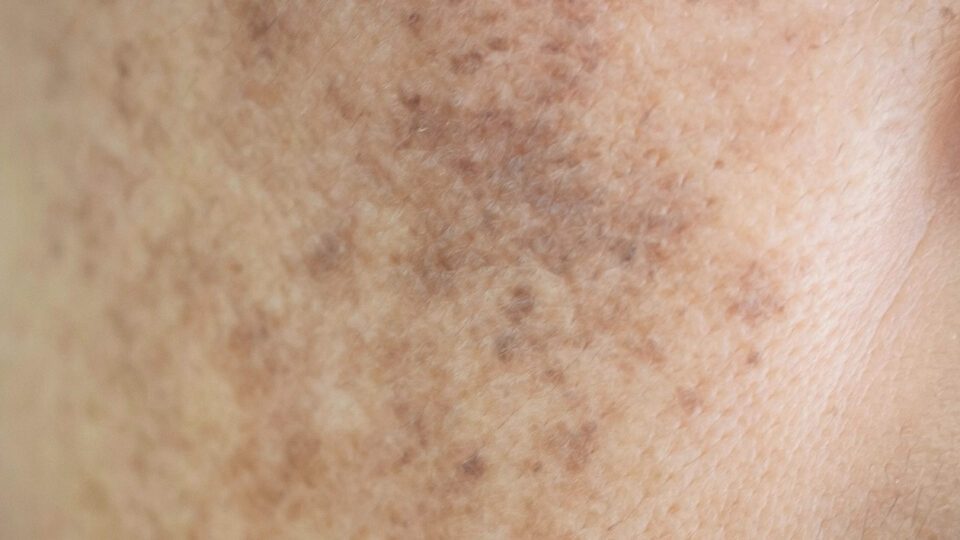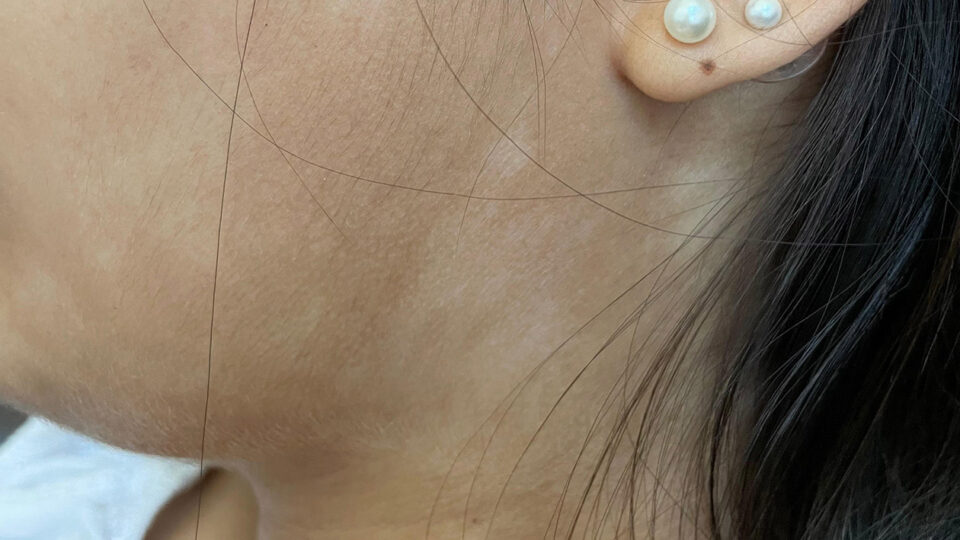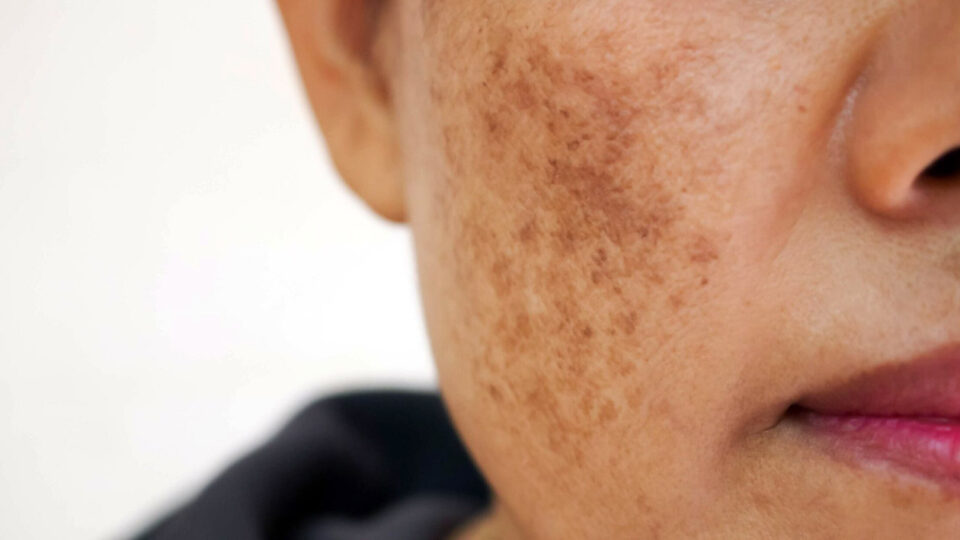What causes Pigmentation?
Pigmentation is primarily caused by melanin, a pigment produced by specialised skin cells called melanocytes. Several factors can influence melanocyte activity and melanin production, leading to variations in skin colour.
- Genetics: Genetic factors play a significant role in determining an individual’s baseline skin colour by influencing the number and activity of melanocytes and the type of melanin produced (eumelanin or pheomelanin) [1].
- Sun Exposure: Ultraviolet (UV) radiation from the sun is a significant cause of increased melanin production, leading to tanning and sometimes hyperpigmentation. The skin produces more melanin to protect itself from UV damage, which can result in darker skin tones.
- Hormonal Changes: Hormones such as estrogen and progesterone can influence melanin production. Conditions like melasma, often seen during pregnancy, are linked to hormonal changes that increase pigmentation [2].
- Medications: Certain medications, including some antibiotics and chemotherapy drugs, can cause changes in skin pigmentation as a side effect. These medications can either increase or decrease melanin production.
- Health Conditions: Some medical conditions, like Addison’s disease, can lead to hyperpigmentation due to hormonal imbalances that increase melanin synthesis.
Types of Pigmentation
There are several types of pigmentation, which can be broadly categorised into hyperpigmentation and hyperpigmentation.

Hyperpigmentation
Hyperpigmentation occurs when there is an excess production of melanin, leading to darker patches on the skin. Common types include:
- Age Spots (Solar Lentigines): These are brown, tan, or black spots that appear on sun-exposed areas of the skin, such as the face and hands, due to prolonged sun exposure.
- Melasma: Often referred to as “the mask of pregnancy,” melasma is characterised by large patches of darkened skin, usually on the face. It is often triggered by hormonal changes, such as those occurring during pregnancy or with the use of birth control pills.
- Post-Inflammatory Hyperpigmentation (PIH): This type of pigmentation occurs following an injury or inflammation of the skin, such as acne or eczema. It can appear anywhere on the body but is more pronounced with sun exposure.

Hypopigmentation
Hypopigmentation is characterised by a reduction in melanin, resulting in lighter patches of skin. Common conditions include:
- Vitiligo: A condition where the skin loses its pigment cells, leading to white patches on different body parts.
- Albinism: A genetic condition resulting in little or no production of melanin, affecting the colour of the skin, hair, and eyes.
- Pityriasis Alba: A common skin disorder in children and young adults, characterised by round or oval hypopigmented patches on the skin.
Understanding these types of pigmentation can help identify and manage various skin conditions effectively.
How can you prevent pigmentation?
Preventing pigmentation, particularly hyperpigmentation, involves several strategies to protect the skin from factors that can trigger excess melanin production. Here are some practical ways to avoid pigmentation:
Sun Protection
- Use Sunscreen: Apply a broad-spectrum sunscreen with at least SPF 30 daily, even on cloudy days. Reapply every two hours outdoors, especially if you are sweating or swimming.
- Avoid Peak Sun Hours: Avoid the sun during its peak intensity, typically between 10 a.m. and 4 p.m.
- Wear Protective Clothing: Wear hats, sunglasses, and clothing covering your skin to minimise sun exposure.
Skincare Routine
- Incorporate Antioxidants: Use skincare products that contain antioxidants, like Vitamin C. These can help brighten the skin and reduce pigmentation by neutralising free radicals [3].
- Gentle Skin Care: Avoid picking or scratching your skin, which can lead to inflammation and subsequent pigmentation.
Dietary Considerations
- Eat a Skin-Healthy Diet: Consuming foods rich in antioxidants, such as citrus fruits, green vegetables, and fatty fish, can support skin health and reduce pigmentation [4].
- Avoid Skin-Stressing Foods: Limit foods that can cause hormonal imbalances, such as excessive dairy, caffeine, and refined sugars.
Avoid Certain Medications
- Some medications can cause pigmentation changes as a side effect. If you suspect medication is affecting your skin, consult with a healthcare provider to explore alternatives.
Implementing these preventive measures can reduce the risk of developing pigmentation issues and maintain a more even skin tone.
Skin Treatments for Pigmentation
Several treatment options are available for pigmentation, particularly hyperpigmentation, which can help even out skin tone and reduce the appearance of dark spots. Here are some common treatments:
Topical Treatments
- Face Acids: These include alpha hydroxy acids (such as glycolic, lactic, and citric acids), azelaic acid, kojic acid, salicylic acid, and vitamin C. These acids exfoliate the top layer of the skin, promote the growth of new skin cells, and help even out skin tone.
- Retinoids: Derived from vitamin A, retinoids can penetrate deep into the skin to promote cell turnover and reduce pigmentation. They are available in both over-the-counter (OTC) and prescription formulations.
- Lightening Creams: These creams often contain hydroquinone, niacinamide, or other skin-lightening agents. They work best for flat spots such as melasma or age spots.
Dermatological Procedures
- Chemical Peels: This involves applying a chemical solution to the skin to exfoliate and remove the top layers, which can help fade dark spots over time.
- Laser Treatments: Laser therapies for pigmentation, such as Fraxel laser, target pigmentation by breaking down melanin deposits in the skin. These treatments can be effective but may require multiple sessions, especially for darker skin tones.
- Intense Pulsed Light (IPL) Therapy: IPL uses light energy to target pigmented areas and reduce their appearance. It is generally more suitable for lighter skin tones.
- Microdermabrasion: A non-invasive procedure that exfoliates the skin, helping to reduce pigmentation by removing the outermost layer of dead skin cells.
Natural Remedies
Some natural ingredients, such as aloe vera, have shown promise in lightening hyperpigmentation, though results may vary and scientific evidence is limited.
It is important to consult with a dermatologist to determine the most appropriate treatment based on your skin type and the underlying cause of pigmentation. Additionally, protecting your skin from sun exposure by using sunscreen daily is crucial to prevent further pigmentation.
Should I be worried about skin pigmentation?
While many pigmentation changes are benign and do not require treatment, monitoring new or evolving skin changes is essential. Regular skin checks and consultations with a dermatologist can help identify and treat any potentially serious conditions early.
When to Be Concerned
Sudden Changes: If you notice sudden changes in skin pigmentation, such as new patches or spots that appear quickly, it is advisable to consult a healthcare provider. These changes could indicate an underlying medical condition that requires attention.
Changes in Moles: Pay attention to any changes in moles, such as size, shape, colour, or texture. These changes could be signs of skin cancer, and it is important to seek medical evaluation promptly.
Associated Symptoms: If pigmentation changes are accompanied by other symptoms, such as itching, pain, or bleeding, it is essential to seek medical advice to rule out any severe underlying conditions.
Understanding pigmentation is like unlocking the secrets behind our skin’s unique beauty and resilience. By appreciating the role of melanin, being mindful of sun protection, and seeking advice from dermatologists when needed, we can embrace our natural colouring and care for our skin’s health for years to come.
Remember, every shade of skin tells a story – a story of genetics, heritage, and the remarkable adaptability of the human body.
